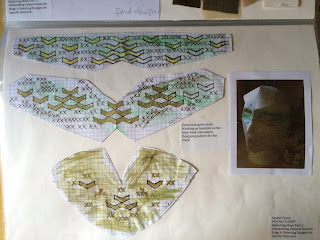The Mask:
I decided to make a facemask, taking my inspiration from headwear and veiling practices in the region I am exploring. Headwear seemed to be
very important (worn by men or women) within Ottoman/Turkish and Circassian
societies at the time. But I am thinking a rather critical approach, parallel
to my mood and response to resent political upheaval in the region disadvantaging
women. I am thinking of a piece representing the oppression of woman under political
agendas. The idea is to embroider the mask with goldwork and some cross stitch.
 |
| Traditional headwear Turkish and Circassian |
My first thought is how to construct a mask? Therefore I did a little research.
The mask designs can lead to dark places. It represents edgy and dark
ideas. Alexadre McQuuen, and Iris Van Harper come to mind. Their mask designs
are intriguing and can turn a person into a beast fashionably!. There are even
darker places: SMs, Necromancers, even Lady Gaga.. I’ll leave them where they are.
 |
| Masks By Designers |
I looked at my drawings of my mums work and decided on the very
geometric design. I hope will look great when worked with goldwork. My colour choices
reflect my pessimistic mood: muddy green. But it will work well with gold. I
chose a satin fabric and bonded it onto cotton with bondaweb to strengthen it.
I ordered a foam head mannequin so I can use it to cut pattern around the
curves of a face for the mask.
 |
| Mask Design Sketches - S Payne |
My first drawings are very sketchy. But they made me decide to divide
the design in several parts and put them later. With the help of mannequin I
cut templates and made sure they fit and work together. I ended up designing 4
parts, 3 will be embroidered.
 |
| Mask Design - Making Patterns S Payne |
Second stage is finalizing the embroidery design. It is very
precise work. There fore I purchased a graph paper notebook. My main problem at
this stage is to figure out how to transfer the design to the fabric and how to
style the embroidery; which stiches or embellishments to use.
 |
| Embroidery Design - S Payne |
I did a test stich. I am ok with the results and decided to use
beads, gold thread for cross stich.
 |
| Test Embroidery - Saadet |
I photocopied the final pattern design onto semi transparent
paper and stitched all the outline onto the fabric. Next I cut and stitch the
felt to raise the structure.
 |
| Transferring design to fabric S Payne |
 |
| Embroidery in progress S Payne |
Next stage is embroidering. It took me good 5 solid days to
embroider 3 pieces.
Final stage is sewing and putting parts together.
The result and the reflections:
I am happy with my final design, the journey I took and the tips
and techniques I learned along the way. My mask reflects my mood, worries, and
concerns regarding women’s struggle. It covers eyes and the mouth representing
not having a voice, not given equal chance. The gold represents the treasure in
us, as women.
 |
| The Mask - Final Piece for Assignment 1- S Payne |
 |
| The Mask - Final Piece for Assignment 1- S Payne |
However I accept the finish in details could be better. It shows
I am rather inexperienced. But I welcomed the challenge and opportunity to
learn. It was a problem-solving task throughout. A very technical challenge.
The results are so simple that you forget how much effort went into it!
I loved to work from my mum’s vintage embroidery. I think I will
continue to do so. I am thinking printing already.
I struggled with this project. During this time I moved house.
It took 18 stressful and unproductive weeks. Now I have a room to myself, and a
house to renovate. Life is always busy. The frustration comes from the feeling
that you are not giving your full focus. When time is in short supply any crisis
feels bigger then it is.
Nevertheless, I soldiered on. It only builds more stamina, isn’t
it?



















